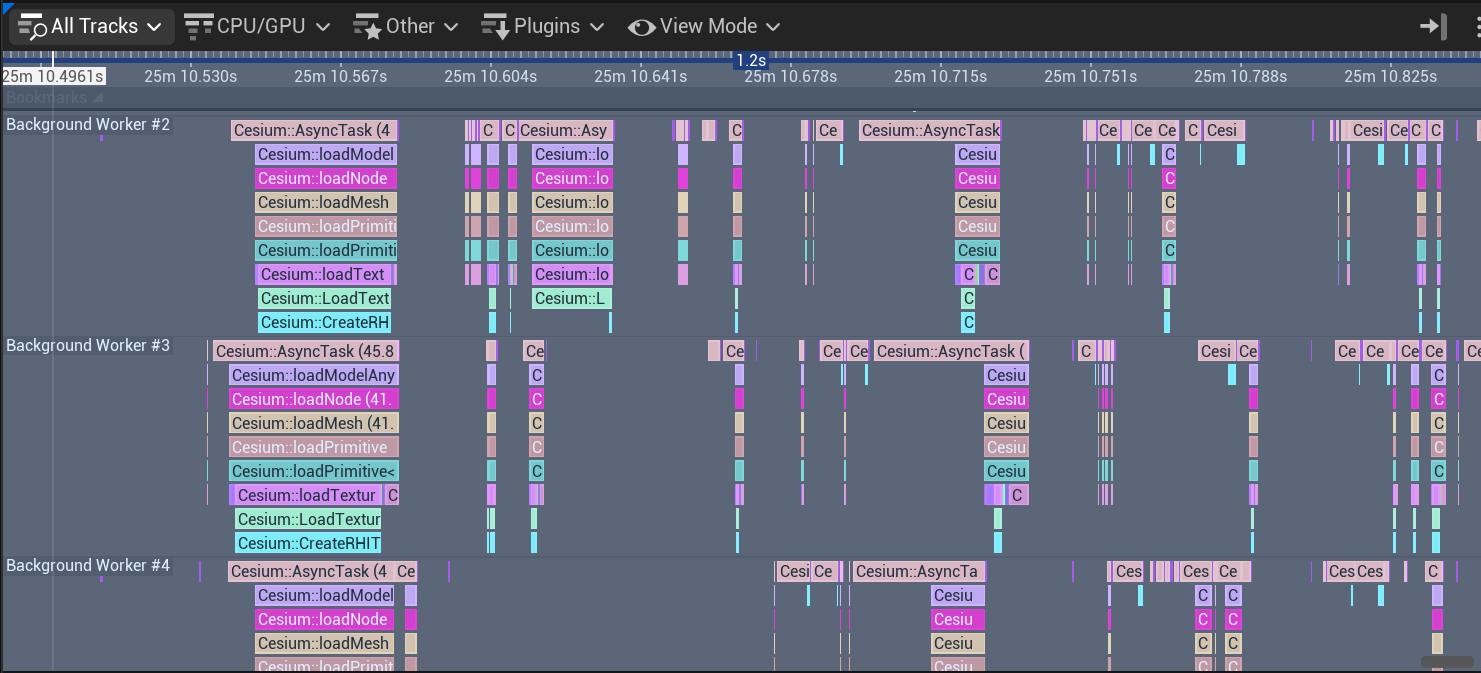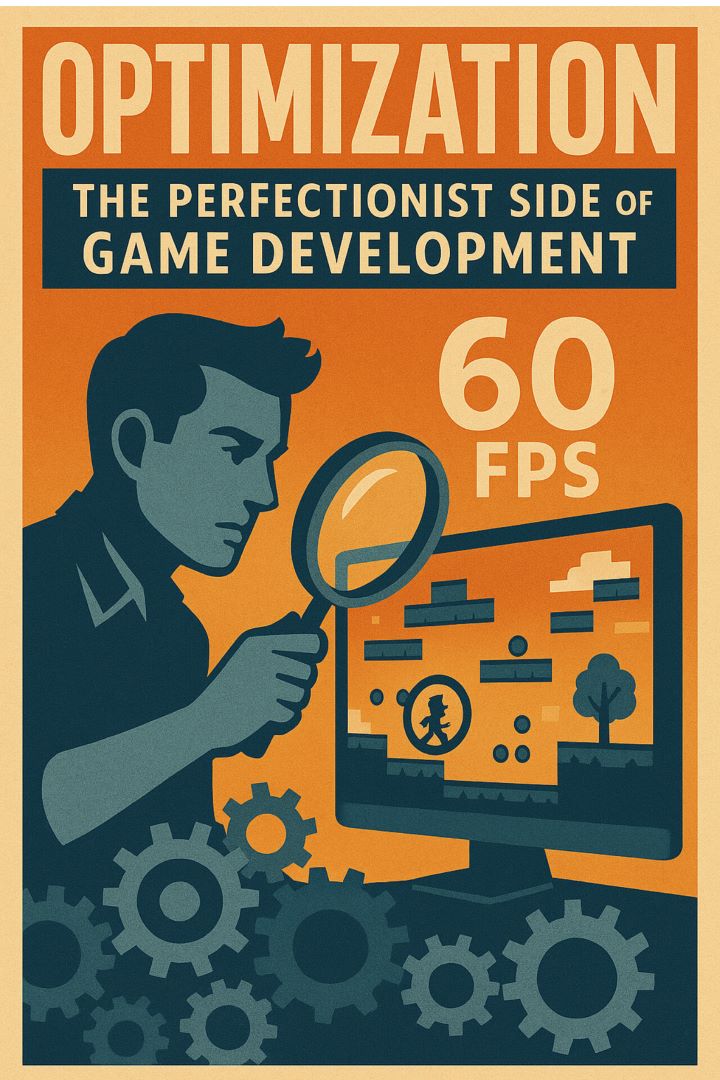⏱️ 14-minute read
Optimization: The Perfectionist Side of Game Development
Optimization is critical in game development — but when does it cross the line into obsession? In this post, we explore the perfectionist mindset many devs fall into, especially with Unreal Engine, where powerful tools can tempt us to fix problems that don’t even exist yet. Learn how to tell the difference between real bottlenecks and unnecessary tweaking, and how to stay focused on shipping instead of spiraling.
📖 Table of Contents
- Introduction: The Optimization Obsession
- The Dark Side: Overthinking Before the Problem Exists
- Unreal Engine: A Playground for the Obsessive
- The Cost of Premature Optimization
- Is It a Bottleneck or a Brain Worm?
- How to Optimize Smart, Not Constantly
- Conclusion: Done > Perfect

1. Introduction: The Optimization Obsession
You know the feeling.
The game is running fine — no crashes, no frame drops, nothing breaking — but something in the back of your mind whispers, “It could be better.” Maybe you shave 0.3ms off a tick, rework a perfectly good Blueprint into C++, or spend an afternoon optimizing a system you haven’t even finished designing yet.
Welcome to the perfectionist side of game development — where “just one more tweak” turns into a five-hour rabbit hole, and where Unreal Engine’s powerful tools make it way too easy to chase performance ghosts.
We tell ourselves it’s about polish. About quality. About doing it “right.”
But sometimes? It’s just a well-disguised form of control — or fear.
In this post, we’re diving deep into the obsession with optimization: why it happens, how it can help (or hurt), and how to know when you’re genuinely improving your game — and when you’re just getting in your own way.

2. The Dark Side: Overthinking Before the Problem Exists
It starts innocently enough.
You’re planning a new system — maybe combat mechanics, a UI layer, or a save/load system — and before you’ve even written a line of code or placed a single Blueprint node, your brain goes:
“Will this cause frame drops on low-end hardware? Should I write a custom subsystem instead of using built-in functions? What if too many instances spawn at once?”
Before you know it, you’re optimizing a ghost.
This is the dark side of the optimization mindset — where overthinking hijacks creativity, and the fear of inefficiency blocks momentum. You’re solving problems that don’t exist yet. You’re building systems around imagined bottlenecks instead of actual gameplay needs. And worst of all? You feel productive while doing it.
In Unreal Engine, this gets especially tricky. The tools are powerful — you can micro-optimize your actors, virtual textures, LODs, draw calls, and logic flow before you’ve even hit “Play.” But just because you can doesn’t mean you should.
Every second spent optimizing something that isn’t broken is time not spent building what matter

3. Unreal Engine: A Playground for the Obsessive
Unreal Engine is a technical marvel. It gives you the keys to an insanely powerful kingdom: Nanite, Lumen, Blueprints, C++, Niagara, World Partition, profiling tools, and optimization settings for everything — down to the GPU memory budget per platform.
For perfectionist developers? It’s paradise.
And it’s a trap.
With so many options and so much control, it’s easy to fall into the illusion that you must tweak and polish everything from day one. You spend hours shaving milliseconds off the tick rate of an actor that might not even make it into the final build. Or you’re deep-diving into texture streaming settings for a placeholder asset.
Unreal’s complexity makes it feel like there’s always something you’re missing — some setting, some flag, some checkbox that’ll magically make your game faster, smoother, “better.” That’s fuel for the obsessive mind.
And yes, the engine rewards performance work — especially when you’re shipping on console or trying to maintain 60fps in VR. But if you’re optimizing your AI behavior tree before you even have enemies on screen? You’re not building a better game. You’re just procrastinating with a performance hat on.
The key is knowing when Unreal is empowering you — and when it’s enabling your obsession.
4. The Cost of Premature Optimization
There’s a popular quote in software development:
“Premature optimization is the root of all evil.” — Donald Knuth
In game development, it might be more accurate to say:
“Premature optimization is the fastest way to kill your momentum.”
When you’re constantly trying to perfect things before they even exist, you’re not speeding up your game — you’re slowing down your progress.
Let’s break down what this obsession actually costs:
🕒 Time You’ll Never Get Back
Every hour you spend squeezing performance out of something that’s not broken is time not spent finishing the thing. That combat system? Still not fun. That level design? Still unfinished. But hey — your tick functions are 4% more efficient.
💡 Creativity on Life Support
When you’re locked in optimization mode, you’re not thinking like a game designer. You’re thinking like a compiler. You’re not asking “What would be fun?” — you’re asking “How many draw calls is this widget making?”
🚫 Ideas That Die Before They’re Born
Premature optimization often kills ideas before they can grow. You don’t try that cool feature because “it might be too expensive.” You don’t test that new system because “it won’t scale well.” You shut down your own creativity in the name of performance that no one’s asking for — yet.
🧠 Mental Drain
The endless loop of “is this efficient enough?” burns you out. It makes game dev feel like a chore instead of a passion project. You start dreading your own work — not because it’s hard, but because you can’t stop poking at it.
Optimizing too early doesn’t make your game better — it just makes it slower to finish. And in game dev, the only optimization that matters is the one that helps you ship.
5. Is It a Bottleneck or a Brain Worm?
Not every slow frame is a crisis.
Not every unoptimized system is a problem.
And not every performance tweak is worth your time — especially if you’re still building the core of your game.
But how do you know if you’re chasing a real bottleneck… or just spiraling into optimization as a way to feel in control?
Here’s how to tell the difference:
✅ Signs It’s a Real Bottleneck:
-
You can measure it. You’re seeing actual FPS drops, hitching, memory spikes — and you’ve verified them with profiling tools like Unreal’s Insights, Stat Unit, or Stat GPU.
-
It impacts gameplay. The issue is visible or affects how the game feels to play. If it ruins the player experience, it’s worth fixing.
-
It happens consistently. You can reliably reproduce the problem in a specific area or moment in the game.
-
You’re near the end of development. Optimization should mostly happen after systems are built and content is in place.
❌ Signs It’s a Brain Worm (a.k.a. You’re Just Obsessing):
-
You’re optimizing a system that isn’t finished or even used in-game yet.
-
There’s no measurable performance hit, but you feel like it “might be slow later.”
-
You’re spending hours on micro-optimizations without building or testing the actual game.
-
You feel anxious when leaving something “imperfect” — even though it works fine.
🎯 Ask Yourself This:
-
Is this issue visible or felt in gameplay?
-
Can I measure it with real data?
-
Would this problem still matter if I was launching tomorrow?
-
Is this stopping me from shipping — or just soothing my inner control freak?
Sometimes, optimization is necessary. But often, it’s a clever way to procrastinate with purpose. Know the difference — or you’ll spend months tuning something you might later delete.

6. How to Optimize Smart, Not Constantly
If optimization is a tool, not a goal, then here’s how to wield it without letting it take over your whole process.
The secret?
Build first. Optimize later. And only when it matters.
Here’s how to stay sharp without spiraling:
🧱 1. Build the Thing First — Even if It’s Ugly
Don’t start with efficiency. Start with functionality. Get your mechanic, system, or feature working. Ugly code? Who cares. High tick rate? Doesn’t matter yet. You can’t optimize what doesn’t exist.
🧪 2. Profile Before You Panic
Use Unreal’s built-in profiling tools to measure before making assumptions. Tools like:
-
Stat Unit -
Stat GPU -
Unreal Insights -
Stat DumpFrame
Only fix what actually shows up in the data. Guessing leads to wasted time and false alarms.
🏃♂️ 3. Optimize What Impacts Players First
Start with what your player will feel. Prioritize:
-
Framerate consistency
-
Loading times
-
Input lag
-
Visual stutters
Don’t chase edge cases in background logic no one notices.
📦 4. Use Proxies, LODs, and Streaming Late
These are powerful, but time-consuming to set up and tune. Save them for when you’ve locked content and layout — otherwise, you’re just rearranging a moving target.
🧠 5. Set “Good Enough” Thresholds
Establish your performance targets. Not everything needs to be perfect:
-
60fps on target hardware?
-
Under 10ms tick time per actor?
-
Reasonable draw call count per scene?
Once you hit the bar, move on. Don’t chase zeros.
🚧 6. Leave Optimization “Hooks” for Later
You can still be smart during development:
-
Add toggles or debug flags for expensive systems.
-
Keep a list of “potential optimization areas.”
-
Write modular code that can be swapped out later.
Just don’t try to finish the polish pass before you’ve finished the game.
Work like this:
Prototype fast → Build systems → Measure performance → Optimize what matters → Ship.
7. Conclusion: Done > Perfect
Perfection feels safe.
It gives you control, direction, certainty.
But in game development? Perfection is a mirage — and chasing it can kill your momentum.
When you’re stuck in the optimization loop, it feels productive. You’re tweaking, tuning, profiling, fixing. But often, you’re just running in circles. You’re improving a system no one’s even going to see — instead of building something players will actually experience.
So here’s the hard truth:
You don’t need a perfect system. You need a finished game.
🔁 Break the Loop:
-
Ship something playable early.
-
Treat “unfinished” as a step — not a failure.
-
Let go of that one system you keep rewriting.
-
Accept “good enough” so you can move forward.
⚡️ Progress Builds Motivation
Every feature you finish gives you energy.
Every milestone you hit builds confidence.
Every system you ship reminds you: you’re actually building a game — not just polishing a fantasy.
🧭 Your Goal Isn’t a Clean Profiler — It’s a Great Game
No one will open your project and admire your event graph organization.
No one will say “wow, that actor’s tick only takes 0.03ms!”
They’ll remember the experience. The gameplay. The feeling.
That’s what matters.
So next time you feel yourself spiraling into another round of unnecessary optimization…
Pause.
Ask yourself:
Is this helping me finish, or just helping me cope?
Then close the profiler and get back to building something real.
☁️ The “Point of Heaven”: Write It Down and Let It Breathe
This isn’t just for game development — it’s for everything.
When your brain locks onto a problem — whether it’s code, life, art, anything — and refuses to let go, try this:
Write it down.
Don’t force a solution.
Let your mind breathe.
Come back to it when you’re ready.
You’ll be surprised how often a “problem” fades when you’re not staring at it. Or how fast the solution shows up when your mind is calm and clear.
This small practice gives you space — mentally and emotionally.
It turns obsession into insight.
It replaces anxiety with clarity.
Try it. It’s not just practical — it’s peace.

🔑 Key Takeaways
- Optimization should follow prototyping, not precede it
- Unreal’s power requires conscious restraint
- Measure first, optimize second
- Shipped games beat perfect code
🏷️

